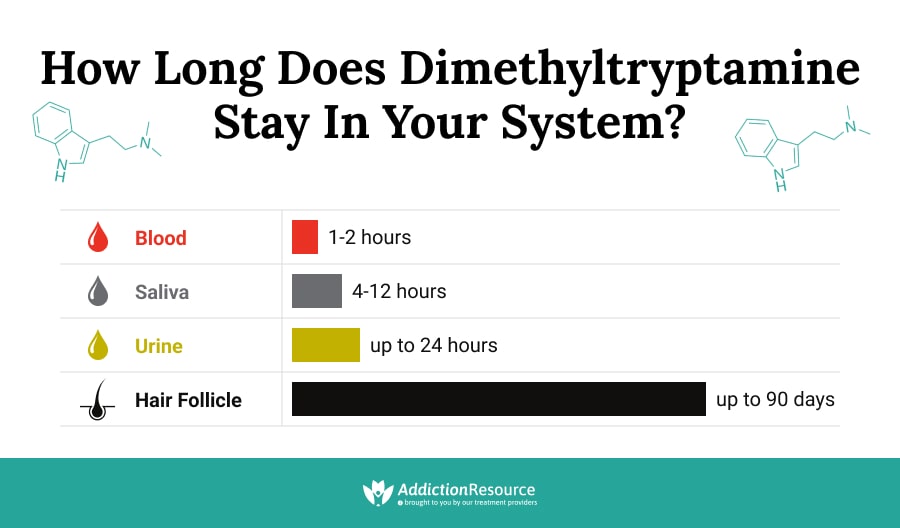N,N-Dimethyltryptamine (DMT) is a prototypical monoamine alkaloid hallucinogenic. It can be found naturally in over fifty species of flora, five species of fauna as well as in the human brain. After 1931 it has also been synthesized synthetically. Thus its use has a long history for its psychedelic and hallucinogenic properties, whether as ceremonial snuffs and brews, such as ayahuasca, used over centuries by the indigenous people of the Amazon or more recently as an illicit DMT drug for recreational use.
Table Of Contents:
- What Is Dimethyltryptamine?
- History of N,N-Dimethyltryptamine
- Modern Scientific Take On Dimethyltryptamine
- Classification of Tryptamines
- What Does Dimethyltryptamine Look Like?
- Is Dimethyltryptamine Legal?
- What Are DMT Drug Effects?
- Long-Term Effects: Warnings And Dangers
- Is Dimethyltryptamine Addictive?
- Who Is Most At Risk Of DMT Addiction?
- How Long Do Effects Last?
- Dimethyltryptamine Overdose: Is it Possible?
- Dimethyltryptamine Addiction Treatment

With the popularity of psychedelic drugs on the rise and the increasing prevalence of DMT drug use due to recent media exposure through cinema and influential magazine articles, it is worth examining what exactly N,N-Dimethyltryptamine is; what the prevalence of DMT drug use is; what demographic uses this drug the most; and most importantly what is the liability and consequence of DMT abuse and DTM addiction. Learn this and much more in the article about N,N-Dimethyltryptamine.
There is still much that is unknown regarding long-term DMT drug use. However, one thing that is for certain is the fact that Dimethyltryptamine use is certainly not without its side effects.
What Is Dimethyltryptamine?
N,N-Dimethyltryptamine is an indolethylamine hallucinogen with a tryptamine core derived from the stepwise chemical modification of the amino acid tryptophan. It can be biosynthesized within various plants, animals, as well as humans, or it can be synthetically produced. Whether naturally or chemically synthesized, Dimethyltryptamine has the capability to produce profound alterations in cognition and perception through its actions on Serotonergic transmission. Historically, N,N-Dimethyltryptamine containing snuffs and teas, such as ayahuasca, were used for ceremonial purposes. Today, the ritualistic use of Dimethyltryptamine-containing brews continues through various syncretic religious movements in South America as well as in the western world. The illicit consumption is primarily related to subjective psychoactive DMT drug effects and to its relatively acceptable side effect profiles.

History of N,N-Dimethyltryptamine
The history of N,N-Dimethyltryptamine use goes back centuries to the indigenous people of the Amazon basin, who brewed the ritualistic ayahuasca tea from the bark of B. caapi and the leaves of P. viridis. It was the leaves of P. viridis that contained Dimethyltryptamine and gave ayahuasca its hallucinogenic and spiritualistic properties desired by the Amazonian shamans. In 1931, Richard Helmuth Manske, a noted German organic chemist who studied the chemistry and physiology of alkaloids, synthesized N,N-Dimethyltryptamine. Following this, in 1946, Oswaldo Gonçalves de Lima, a Brazilian chemist, and microbiologist discovered Dimethyltryptamine as a natural chemical in the root bark of Mimosa tenuiflora. However, it was not until the studies of Hungarian chemist and psychiatrist Stephen Szara in 1956 that the hallucinogenic properties of Dimethyltryptamine were discovered. Forming a link between the historical use of Dimethyltryptamine-containing plants and modern-day science. Since then, Dimethyltryptamine has been discovered in numerous plants, animals, and even within the blood and urine of normal human subjects. In recent decades, research into N,N-Dimethyltryptamine has revived and is looking at DMT therapy as a possible future tool.
Modern Scientific Research On N,N-Dimethyltryptamine
Scientific research involving hallucinogens began in the latter half of the 20th century with their discovery, but research was hindered by the introduction of the Controlled Substances Act in the 1970s. In recent decades, research into the endogenous roles of Dimethyltryptamine has revived. Today scientists are looking at DMT chemical structure and its functions at various receptors: serotonergic, glutaminergic, cholinergic, dopaminergic, Trace Amine-Associated Receptors, and Sigma-1 receptor. Research is looking into the role of this compound in organically occurring states of consciousness such as dreams, creativity, imagination, religious or spiritual phenomenon, psychosis, and near-death experiences. The combination of this research is hoped to provide answers and allow the use of DMT therapy as a future tool in the treatment of mental health disorders, substance abuse, inflammation, and even cancer.
Classification of Tryptamines
Although in this article we focus on N,N-Dimethyltryptamine, there are numerous other tryptamines that are also hallucinogenic but with unique characteristics due to being slightly different from the DMT chemical structure. Below are listed some commonly encountered tryptamine hallucinogens:
- Alpha-methyltryptamine (AMT) a potent monoamine reuptake inhibitor with additional effects on serotonin transmission and inhibition of MAO activity. AMT can cause visual hallucinations and euphoria, with anxiety, irritability, nausea, anorexia, vomiting, insomnia, tachycardia, hypertension, and mydriasis.
- Diethyl-tryptamine (DET) is another synthetic serotonergic tryptamine with similar effects as Dimethyltryptamine but a longer duration of action.
- Dipropyl-tryptamine (DPT) is also another synthetic serotonergic tryptamine whose use is associated mostly with psychedelic sensations such as an increase in the intensity of colors and sound, pleasant flashes of light, and sparks, loss of ego, and hallucination of faces.
- Diisopropyl-tryptamine (DiPT) is yet another synthetic tryptamine whose use is mainly associated with complex auditory abnormalities.
- 5-methoxy-α-methyltryptamine (5-MeO-AMT) is a tryptamine that is structurally similar to amphetamines. This agent is often misinterpreted as LSD and incorrectly used, leading to potentially fatal arrhythmias.
- 5-methoxy-N,N-dimethyltryptamine (5-MeO-DMT) is another naturally occurring psychoactive indolealkylamine substance with a slight variation to the DMT chemical structure, but very fast-acting.
- 5-methoxy-diisopropyltryptamine (5-MeO-DiPT) sometimes referred to as “Foxy Methoxy” is associated with feelings of euphoria, disinhibition, increased sociability, visual and auditory hallucinations, and amorous feelings.

What Does Dimethyltryptamine Look Like?
Naturally, occurring Dimethyltryptamine can come in a variety of plants and their derivative dried herbs and brewed teas which are ingested orally.
- One commonly known plant, especially to ayahuasca users, that contains Dimethyltryptamine is Psychotria Viridis. P. Viridis is a shrubby, perennial, flowering plant that can be found all over central and south America.
- Other genera of plants that also contain Dimethyltryptamine include Acacia, Delosperma, Desmodium, Mimosa, Phalaris, Psychotria, Virola.
Synthetically produced N,N-Dimethyltryptamine can be found as a white powder or a tablet.
Is N,N-Dimethyltryptamine Legal?
In the United States, Dimethyltryptamine is a Schedule 1 drug under the Controlled Substances Act, which defines Dimethyltryptamine as a drug with no currently accepted medical use and a high potential for DMT abuse. Furthermore, Dimethyltryptamine is currently not approved for the treatment of any medical disorders by the FDA.
However, Dimethyltryptamine containing ayahuasca is legal for religious use under the 2006 Religious Freedom Restoration Act.
In Canada, under its Controlled Drugs and Substances Act, Dimethyltryptamine is a Schedule III substance making it illegal.
In the United Kingdom, Dimethyltryptamine is categorized as a Class A controlled substance, making it illegal to possess, produce, or supply it.
What Are DMT Drug Effects?
The effects of N,N-Dimethyltryptamine are thought to be mediated primarily through serotonin receptors. However, action at only these receptors is insufficient to account for all of DMT drug effects. Thus, it must also act at various other receptors such as glutamate, dopamine, acetylcholine, TAAR, and sigma-1 receptors.
Mental and Psychological Effects of DMT Abuse
The mental effects of use and abuse are subjective and varied, but the most common mental DMT drug effects include altered cognition manifested by visual, auditory, and tactile deformities and hallucinations. Also, users report a sense of detachment or dissociation from one’s body.
Furthermore, from user self-reported adverse mental side effects included a “bad trip” 51% and psychospiritual problems(39%).
Physical Effects of Dimethyltryptamine:
The common physical DMT drug effects are not severe, especially if oral ingestion is avoided. This factor is thought to contribute to the possible risk of DMT abuse and DMT addiction.
- Hypertension
- Tachycardia
- Mydriasis
- Nystagmus
- Nausea and vomiting
- Respiratory irritation
Less Commonly Encountered but Severe Side Effects Could Include:
- Dizziness and Ataxia
- Agitation
- Seizures
- Coma
- Respiratory arrest
Thus, Dimethyltryptamine use is certainly not without its side effects. Nor are these an exhaustive list of possible mental and psychological DMT drug effects which are highly subjective and unique to the user’s DMT experience.

Long-Term Effects: Warnings And Dangers
Long Term effects of use are unknown as studies analyzing sustained psychedelic use on the human brain are lacking. From the limited information that is available, prolonged use of hallucinogenic drugs causes structural changes within the brain. These changes are associated with those brain areas that support attentional processes, self-referential thought, and internal mental processes. All of this can lead to an altered personality in people with chronic DMT addiction and DMT abuse.
Furthermore, Generalized Negative Long-Term Dangers Associated With Any Hallucinogenic Use Include:
- A state of chronic visual disturbances, disorganized thinking, paranoia, and mood changes referred to as Persistent Psychosis
- Spontaneous recurrences of certain aspects of the overall DMT experience such as visual disturbances or hallucinations are referred to as Persistent Flashbacks
There is still much that is unknown regarding long-term DMT drug use. However, one thing that is for certain is the fact that Dimethyltryptamine use is certainly not without its side effects.
Is Dimethyltryptamine Addictive?
Although recreational use of Dimethyltryptamine had a life-time prevalence of 9%, DMT addiction and/or DMT abuse are not very prevalent amongst the variety of illicit drugs that are abused by people. However, a study that evaluated the prevalence, user characteristics, and abuse liability as compared to other hallucinogenic drugs, found DMT drug as the most preferred psychedelic among users as it has a rapid onset of action when used, strong pleasurable effects, few negative effects, relatively mild come-down, and a relatively low risk of harm as compared to other hallucinogenic substances. All of these characteristics could potentially increase the liability for DMT abuse and DMT addiction. However, the opposite seems to be true and it is classified as having a low potential for abuse and addiction.
Dimethyltryptamine Addiction Signs
Although addiction is not prevalent there are certain symptomatic signs and clues that could hint at a possible addiction.
Physical Signs Of Addiction:
- Raised heart rate
- Raised blood pressure
- Dilated pupils
Psychological Signs Of Addiction:
- Visual hallucinations
- Simple auditory hallucinations
- Proprioceptive Dissociation
- Sense of “deep introspection
These symptoms are not all that different from the acute effects of a “DMT experience”, however during abuse or addiction they may be more pronounced and more frequent.
Dimethyltryptamine use is certainly not without its side effects. Possible mental and psychological DMT drug effects are highly subjective and unique to the user’s DMT experience.
Who Is Most At Risk Of DMT Addiction?
According to the recent study, the following demographics are more prone to use and possibly addiction:
- White individuals have the highest life-time prevalence of use of all races at .9%
- Individuals with less than a college degree are reported to have a higher life-time incidence of use
- Life-time prevalence of use doubled among people earning less than $20,000 a year
- Life-time prevalence was also increased among those people who used other hallucinogenic substances such as Marijuana, LSD, ketamine, Psilocybin, Peyote, and Mescaline
How Long Does DMT Last?
The duration of effects, in other words, the amount of time a person experiences the effects of the drug, is directly dependent on the half-life of a drug. The major factor that influences the half-life of Dimethyltryptamine is its route of administration, which determines whether the drug will be subjected to hepatic-first pass metabolism.
Therefore, Dimethyltryptamine ingested orally alone is subject to extensive hepatic metabolism by Monoamine Oxidases, whereas Dimethyltryptamine administered intravenously or by smoking avoids this metabolism. This reflects why the duration of effects and as such the half-life of this agent is slightly different based on the route of administration.
Furthermore, individual variations such as the person’s age, overall health, organ (heart, liver, kidney, lung) function, and several other variables can also affect how long the effects of Dimethyltryptamine will last.

How Long Does Dimethyltryptamine Stay In The System
Dimethyltryptamine is rapidly metabolized into various metabolites by hepatic Monoamine oxidases and rapidly excreted. Although Dimethyltryptamine and other hallucinogens are not always checked on routine drug tests, they can still be tested if required.
- Detection within saliva and blood can only be done within 1-2 hours after oral ingestion, due to rapid metabolism and excretion as mentioned above.
- DMT traces are detectable in saliva between 4 and 12 hours.
- Trace amounts can be detected in urine within 24 hours.
- Detection in hair follicles is possible for up to 90 days.
As always individual parameters such as the person’s cardiac, hepatic, and renal health affect how drugs will be absorbed, metabolized, and excreted. As such variability in the aforementioned information is possible.

Dimethyltryptamine Overdose: Is It Possible?
Overdose is defined as the consumption of a drug or another substance in quantities that are far greater than recommended, which leads to severe adverse consequences to one’s health. Dimethyltryptamine by itself has a very low tendency for DMT overdose, and it is rapidly metabolized regardless of the route of administration, and it is almost never used in large quantities for recreational use. However, if Dimethyltryptamine is concurrently taken with other medications such as Monoamine Oxidase Inhibitors, in order to prevent its degradation and prolong the psychedelic experience or the wrong dosage is taken in these cases a DMT overdose could occur.
A Tryptamine Overdose Can Be Characterized By:
- Hypertension
- Hyperpyrexia
- Hyper-alertness
- Mydriasis
- Sweating
- Moderate tremor
- Delay in response times
- Restlessness
- Exaggerated startle reactions
- Visual hallucinations
Has Anyone Died From DMT?
Although uncommon and not associated with specifically DMT, a review of literature has yielded several cases of patients who have died from using tryptamines, chiefly Alpha-methyltryptamine (AMT). Thus to answer the question of “Can you die from DMT?” the answer would be yes if used incorrectly and in very high doses.
Dimethyltryptamine Withdrawal
Dimethyltryptamine is not characterized by dependence or development of tolerance. As such, no evidence of withdrawal symptoms associated with Dimethyltryptamine use can be found in the literature. However, long-term use of Dimethyltryptamine can be associated with persistent negative side effects as mentioned above.
Dimethyltryptamine Addiction Treatment
Dimethyltryptamine addiction treatment is based on a combination of actions that are aimed at achieving a drug-free life. It is also worth noting that no specific therapy exists that is tailored for the treatment of Dimethyltryptamine addiction.
The first step involved is the choice of the right type of rehabilitation therapy for addiction treatment. Whether this is Cognitive Behavioral Therapy(CBT), Psychodynamic Therapy various types of counseling, and or simply user education. These therapies can be done which can be done at both inpatient and outpatient rehab facilities.
The goals of addiction treatment involve:
- Determining why a person started using hallucinogens
- Identifying personal problems and triggers behind substance abuse
- Learning to avoid those situations which are associated with hallucinogen use
- Establishing new ways of dealing with everyday problems.
- Creating new coping mechanisms without the drug.
- Establishing a strong support system for the user
- Establishing “aftercare” programs that could involve support groups and 12-step programs which ensure that the patient stays on track and remains abstinent from the drug.
Related Topics
Hope Without Commitment
Find the best treatment options. Call our free and confidential helpline
Most private insurances accepted
Page Sources
- Bouso, J. C., Palhano-Fontes, F., Rodríguez-Fornells, A., Ribeiro, S., Sanches, R., Crippa, J. A., Hallak, J. E., de Araujo, D. B., & Riba, J. (2015). Long-term use of psychedelic drugs is associated with differences in brain structure and personality in humans. European neuropsychopharmacology : the journal of the European College of Neuropsychopharmacology, 25(4), 483–492. https://doi.org/10.1016/j.euroneuro.2015.01.008
- Carbonaro, T. M., Forster, M. J., & Gatch, M. B. (2013). Discriminative stimulus effects of N,N-diisopropyltryptamine. Psychopharmacology, 226(2), 241–246. https://doi.org/10.1007/s00213-012-2891-x
- Frecska, E., Bokor, P., & Winkelman, M. (2016). The Therapeutic Potentials of Ayahuasca: Possible Effects against Various Diseases of Civilization. Frontiers in pharmacology, 7, 35. https://doi.org/10.3389/fphar.2016.00035
- Kamour, A., James, D., Spears, R., Cooper, G., Lupton, D. J., Eddleston, M., Thompson, J. P., Vale, A. J., Thanacoody, H. K., Hill, S. L., & Thomas, S. H. (2014). Patterns of presentation and clinical toxicity after reported use of alpha methyltryptamine in the United Kingdom. A report from the UK National Poisons Information Service. Clinical toxicology (Philadelphia, Pa.), 52(3), 192–197. https://doi.org/10.3109/15563650.2014.885983
- Palamar, J. J., & Le, A. (2018). Trends in DMT and other tryptamine use among young adults in the United States. The American journal on addictions, 27(7), 578–585. https://doi.org/10.1111/ajad.12803
- Sogawa, C., Sogawa, N., Tagawa, J., Fujino, A., Ohyama, K., Asanuma, M., Funada, M., & Kitayama, S. (2007). 5-Methoxy-N,N-diisopropyltryptamine (Foxy), a selective and high affinity inhibitor of serotonin transporter. Toxicology letters, 170(1), 75–82. https://doi.org/10.1016/j.toxlet.2007.02.007
- Winstock, A. R., Kaar, S., & Borschmann, R. (2014). Dimethyltryptamine (DMT): prevalence, user characteristics and abuse liability in a large global sample. Journal of psychopharmacology (Oxford, England), 28(1), 49–54. https://doi.org/10.1177/0269881113513852

 Authored by
Authored by  Reviewed by
Reviewed by 

